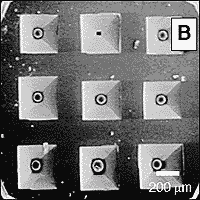
There are numerous types of integrated circuits. A basic category of ICs are memory chips which are called commodity chips because they are sold in large volumes with small profit margins. The most common type of commodity chips are DRAMs, dynamic random access memory. These memory chips do not hold their memory when power is turned off. An increasingly important type of memory chip is Flash memory that maintains its memory when power is turned off.
Microprocessors used in PCs, communication devices, and control
processes such as controlling automobile engines, appliances, or smart
cards are produced in intermediate volumes.
At the other extreme are specialty chips which are designed for a
specific purpose and produced in small lots.
Microelectronics
MEMS technology is Micro-Electonic-Mechanical Systems that extends ICs by integrating other types of components such as mechanical components. Two examples here are presure sensors and accelerometers. An example of the latter is the MEMS device to activate an air bag in a car. MEMS devices can also include RF (radio frequency) circiuts and with technological advances should improve communications in general. For example, RFID or radio frequency identification tages are now replacing bar codes for inventory and other identification tasks. Another new type of sensor has the name Smart Dust because these sensors are so small that they can float in space and communicate back their measurements. These sensors will be especially useful in dangerous situations such as the military, nuclear and other industrial accidents, and police work.
MEMS Technology
An example of complining MEMS with chemical sensors is Sandia Labs research in creating sensors to detect enviromental degradation.
Recently progress has been made right here at UT in taste. The E-tongue has arrays of pyramidal pits filled with plastic beads that hold chemical receptors in an IC:

The chemical receptors turn different colors when exposed to liquid and solid food. The taste is recorded by recording the light patterns in a special camera. Once this technology is perfected the E-tongue could be fitted with a very large number of different type of receptors to create a much more sensitive tongue than the human tongue. For a second electronic is the ASTREE electronic tongue
In the food and beverage industry such E-tongues will be used to compare tests of products with libraries of previously tasted products. The E-tongue will also be used in medical diagnosis to screen blood and urine samples to taste for such chemicals as cholesterol or cocaine. It can also be used to detect toxins in water. A Swedish dairy uses an e-tongue to speed up production.
Chemical and Taste
There are several competing technologies for the E-nose. We will present the E-nose being developed by Nordic Sensor Technologies. A schematic of their E-nose is:

Where E-noses differ is the technology to detect various types of gas molecules. Where they are similar is that most require a neural network program to recognize the type of order present.
Nordic Sensor Technologies uses ten MOSFET gas sensors. Over time the number and types of gas sensors is almost certainly likely to grow. By using specialized groups of gas sensors, E-noses can be used in specific tasks.
Some uses of E-noses are:
Affymetrix and Stanford have developed an IC that can perform DNA analysis. These ICs combine IC technology with application-specific oligonucleotide arrays. The nucleic acid to be analyzed is amplified and labeled with a fluorescent marker. The labeled target is then exposed to the detection IC. The positions where the detection IC is fluorescent tell through complimentarity the DNA sequences of the target. This technology will probably have an explosive growth in the 21st century. Research in bio chips is taking place at many institutions:
As I understand the limits of nanotechnolgy there are two branches. One is the creating compound by manipulating materials at the molecular level such as coatings and paints. Some of these products may be super toxic. The other is the creation of machines at the molecular level such as integrated circuits. This is a hot research area that is now the first branch is entering the commercialization period. There are serious risks to all lifeforms when nanoparticles enter the environment
Another technology, which is closely related to electronic ICs, is
optoelectronics that are microsemiconductor devices to process laser
light and convert electricity into light or vice versa. With fiber
optics becomming the most important technology for communication this
is a vast area of applications. Another area is production of
electricity for sunlight using solar cells. One example is the
semiconductor laser the size of a grain of sand. Other examples are
encoders and decoders transferring signals from and to electricity in
fiber optic communication networks. This technology is the basis for
the race to build high quality, inexpensive flat TV and computer
screens. In this field there is intense international competition.
Right now computation is done using electricity and communication
light. It is possible computation could be done using
light. See first reference.
Light